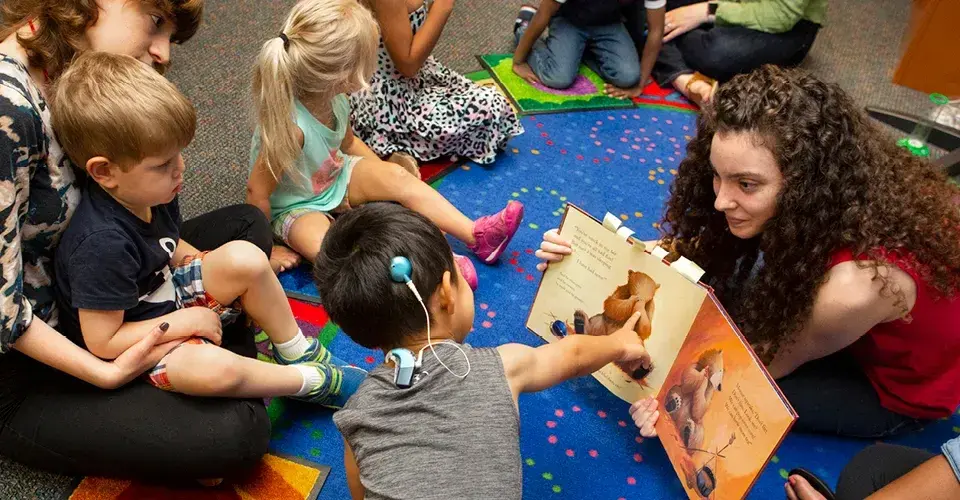Learning to Listen
UMD Hosts New Cochlear Implant Intensive Program for Kids
by Annie Dankelson | Photos by Stephanie S. Cordle
A summer symphony floats from a classroom in LeFrak Hall. Children shake maracas, ding triangles and ring bells.
To the side is a less typical scene: Graduate students fiddle with the youngsters’ cochlear implants and hearing aids, making sure they’re working before xylophone chimes beckon everyone to the carpet for circle time.
In July, the Maryland Cochlear Implant Center of Excellence in the Department of Hearing and Speech Sciences introduced a two-week program for kids ages 3-6 who have significant hearing loss and use hearing aids or cochlear implants. The center, an MPowering the State initiative, unites educational, clinical and research strengths from the University of Maryland, College Park with medical expertise and research from the University of Maryland School of Medicine in Baltimore. Its new Summer Cochlear Implant Intensive Program provides therapy and fun activities to build auditory and speech-language skills.
The children mesh easily in their play, even though they can’t communicate fluently through speech.
“They really don’t make judgments about other people,” Director Nicole Nguyen says of this age group. “So it’s really great to see them kind of interacting when they don’t even really use the same language right now.”
Approximately 58,000 cochlear implants had been given to adults and 38,000 to children in the United States as of December 2012, the most recent number available from the National Institute on Deafness and Other Communication Disorders.
While hearing aids increase sound volume through the natural hearing system, a cochlear implant actually replaces damaged, crucial sensory receptors called hair cells in the inner ear, sending electrical impulses to the auditory nerve. But going from thousands of hair cells to 20 or so electrodes results in imperfect sound resolution, so children have to get the hang of using the implants. That’s where this summer program comes in.
On the carpet, six kids watch as Jackie Berges, a graduate student in speech-language pathology leading the class, introduces the book “Bear Snores On.” Hearing ability varies from child to child: Fiona came to the United States from Vietnam and wears two cochlear implants. Duro, the youngest of the bunch at 2 1/2, uses hearing aids. Aaron, a typically hearing boy, serves as a model for the others, gabbing about how he’s read this book at his grandparents’ house.
Speaking through a microphone worn like a necklace, Berges reads descriptions of animal characters, keeping the book facing her so the children can’t see. She then turns the book around. “Can you find the gopher?” she asks each camper. The wren? The hare?
“It looks a little awkward sometimes,” Nguyen says of initially hiding the book’s illustrations, “but it’s very purposeful.”
It’s an example of the auditory-verbal approach the program uses. The audio-first method focuses on hearing and reacting to sound to strengthen kids’ skills in those areas.
“We present the auditory information first, so they learn to listen for the sound. We present the visuals later, so they can connect these two sensory experiences to understand the meaning,” Berges says. “They learn a lot just by playing with each other, through osmosis.”
Some parents’ goals for their children are simple: Duro’s mother, Opeyemi Soewu, hopes she gets more comfortable in a classroom setting. Some are loftier: Fiona primarily uses sign language, but her father, Giang Nguyen, would like her to try speaking first. With individual therapy sessions twice a day the kids can progress more quickly than during school, when they might have therapy once a week.
“The teacher will tell her to say, ‘More,’” Soewu says of Duro. “If she asks for more, they give her more bubbles. If she doesn’t ask for more, they don’t give her any bubbles. She can master it. She can be familiar with these words.”
Following an outdoor water-table activity and lunch, the children circle around Berges again as she shows a video of dancing animals, holding a microphone up to the tablet to amplify the sound. The kids then mimic the moves, each declaring which animal they should imitate.
“Hop like a bunny,” Fiona says slowly into the microphone.
It’s a small victory, the kind that the camp’s leaders hope continues as they look to eventually extend the program year-round, opening the world of hearing and speech to even more children.
0 Comments
Leave a Reply
* indicates a required field

